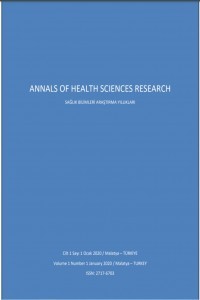Gastroözefageal Reflü Hastalığı Tanısı Konan Çocuklarda Dental Erozyon Prevalansı
Dental Erozyon, Gastroözefageal Reflü Hastalığı, Prevalans
Dental Erosion Prevalance In Children Diagnosed With Gastroesophageal Reflux Disease
Dental Erosion, Gastroesophageal Reflux Disease, Prevalance,
___
- 1. Johansson AA, Sorvari R, Birkhed O, Mevirman JH. Dental erosion in deciduous teeth-an in vivo and an in vitro study. J Dent 2001; 29(5): 333-40.
- 2. Kelleher M, Bishop K. Tooth surface loss: an overview. Br Dent J 1999; 186(2): 61–6.
- 3. Litonjua LA, Andreana S, Bush PJ, Cohen RE. Tooth wear: Attrition, erosion and abrasion. Quintessence Int 2003; 34(6): 435-46.
- 4. Lussi A. Erosive tooth wear - a multifactorial condition of growing concern and increasing knowledge. Monogr Oral Sci 2006; 20: 1-8.
- 5. Rios D, Honorio HM, Magalhaes AC, Buzalaf MA, Palma-Dibb RG, Machado MA. Influence of toothbrushing on enamel softening and abrasive wear of eroded bovine enamel: an in situ study. Braz Oral Res 2006; 20(2): 148-54.
- 6. Addy M, Shellis RP. Interaction between attrition, abrasion and erosion in tooth wear. Monogr Oral Sci 2006; 20: 17-31.
- 7. O'Sullivan EA, Milosevic A. UK National Clinical Guidelines in Paediatric Dentistry: diagnosis, prevention and management of dental erosion. Int J Paediatr Dent 2008; 18 (Suppl 1): 29-38.
- 8. Bayrak Ş, Ökte Z. Dental erozyon.[Dental Erosion] Ondokuz Mayıs Üni Diş Hek Fak Derg 2005; 6: 201-8.
- 9. Scheutzel P. Etiology of dental erosion-intrinsic factors. Eur J Oral Sci 1996; 104(2): 178-90.
- 10. Zero DT. Etiology of dental erosion-extrinsic factors. Eur J Oral Sci 1996; 104(2): 162-77.
- 11. Yağcı RŞ. Gastroözfageal reflu hastalığı.[Gastroosefageal reflux disaese]. Güncel Pediatri 2006; 4(2): 56-65.
- 12. Sarı ME, Koyutürk AE. Çocuklarda gastoözefageal reflünün süt ve daimi diş erozyonu ile ilişkisi: literatür derlemesi. [Relationship to erosion of primary and permanent teeth of gastroosefageal reflux in children: A literature review]. Cumhuriyet Dent J 2010; 13(2): 81-5.
- 13. O’Sullivan EA. A new index for measurement of erosion in children. Eur J Peadiatric Dent 2000; 2: 69- 74. In: Peres KG, Armenio MF, Peres MA, Traebert J, Lacerda De JT. Dental erosion in 12 year old scoolchildren: a cross-sectional study in Southern Brazil. Int J Paediatr Dent 2005; 15(4): 249-55.
- 14. Young A, Amaechi BT, Dugmore C, Holbrook P, Nunn J, Schiffner U, et al. Current erosion indices--flawed or valid? Summary. Clin Oral Investig 2008; 12 (Suppl 1): 59-63.
- 15. Çağlar E, Kargül B, Tanboğa I, Lussi A. Dental erosion among children in an Istanbul public school. J Dent Child 2005; 72(1): 5-9.
- 16. Çoğulu D, Menderes M, Ersin N. Çocuklarda Dental Erozyon. [Dental Erosion in Children] Turkiye Klinikleri J Dental Sci. 2009; 15: 87-92.
- 17. Ünlü N, Karabekiroğlu S, İleri Z, Şener S. Prevalence of dental erosion and association between socioeconomic factors in Turkish children. Selçuk Dent J 2014; 2: 49-54.
- 18. Meurman J, Toksala J, Nuutinen P, Klemetti E. Oral and dental manifestations in gastroesophageal reflux disease. Oral Surg Oral Med Oral Pathol 1994; 78(5): 583-9.
- 19. Bartlett D. Intrinsic causes of erosion. Monogr Oral Sci 2006; 20: 119-39.
- 20. Auad SM, Waterhouse PJ, Nunn JH, Moynihan PJ. Dental caries and its association with sociodemographics, erosion, and diet in schoolchildren from southeast Brazil. Pediatr Dent 2009; 31(3): 229- 35.
- 21. Mcguire J, Szabo A, Jackson S, Bradley G, Okunseri C. Erosive tooth wear among children in the United States: Relationship to race ethnicity and obesity. Int J Paediatr Dent 2009; 19(2): 91-8.
- 22. Jarvinen V, Rytomaa I, Meurman JH. Localisation of dental erosion in a referred population. Caries Res 1992; 26(5): 391-6.
- 23. Arnadottir IB, Holbrook WP, Eggertsson H, Gudmundsdottir H, Jonsson SH, Gudlaugsson JO, et al. Prevalence of dental erosion in children: a national survey. Community Dent Oral Epidemiol 2010; 38(6): 521–6.
- 24. Aidi HE, Bronkhorst EM, Huysmans MC, Truin GJ. Factors associated with the incidence of erosivewear in upperincisors and lowerfirstmolars: a multifactorial approach. J Dent 2011; 39(8): 558-63.
- 25. Jarvinen V, Meurman JH, Hyvarinen H, Rytomaa I, Murtomaa H. Dental erosion and upper gastrointestinal disorders. Oral Surg Oral Med Oral Pathol 1998; 65(3): 298-303.
- 26. McDerra EJ, Pollard MA, Curzon MEJ. The dental status of asthmatic British school children. Pediatr Dent 1998; 20(4): 281–7.
- 27. Shaw L, O’Sullivan E. UK National Clinical Guidelines in Paediatric Dentistry. Diagnosis and prevention of dental erosion in children. Int J Paediatr Dent 2000; 10(4): 356–65.
- 28. Dugmore CR, Rock WP. A multifactorial analysis of factors associated with dental erosion. Br Dent J 2004; 196(5): 283–6.
- 29. Bardolia P, Burnside G, Ashcroft A, Milosevic A, Goodfellow SA, Rolfe EA, et al. Prevalence and risk indicators of erosion in thirteen- to fourteen-year-olds on the Isle of Man. Caries Res 2010; 44(2): 165-8.
- 30. El Aidi H, Bronkhorst EM, Truin GJ. A longitudinal study of tooth erosion in adolescents. J Dent Res 2008; 87(8): 731-5.
- Başlangıç: 2012
- Yayıncı: İnönü Üniversitesi
Gastroözefageal Reflü Hastalığı Tanısı Konan Çocuklarda Dental Erozyon Prevalansı
Tuğba BEZGİN, Zeynep Başak YILMAZ, Cansu KOÇYİĞİT, Nuray Uslu KIZILKAN, Ceyda Tuna KIRSAÇLIOĞLU, Nurhan ÖZALP
Alper KIZILDAĞ, Taner ARABACI, Ezgi DOĞANAY
Bebeklik Dönemi Gelişiminde İşitme Algısı
Hemşirelerin Hastane Enfeksiyonlarını Önlemeye İlişkin Bilgi Düzeyleri
Talip MANKAN, Mağfiret Kara KAŞIKÇI
PTPN11 Gen Mutasyonu: Noonan Sendrom’lu Bir Olgu
Serdar KARATOPRAK, Emine YAŞAR, İbrahim TEKEDERELİ
Elçin Latife KURTOĞLU, İdris ŞAHİN, Hülya TAŞKAPAN, Elif YEŞİLADA, Başak KAYHAN
Zekeriya ÇALIŞKAN, Sermin Timur TAŞHAN, İlksen ORHAN, Gülçin NACAR
